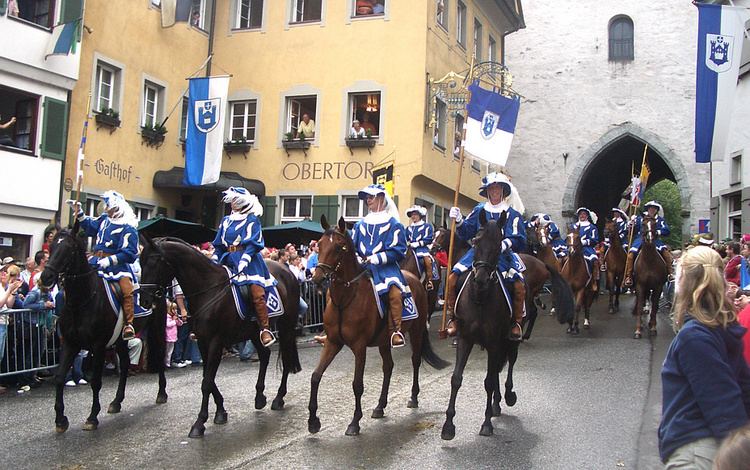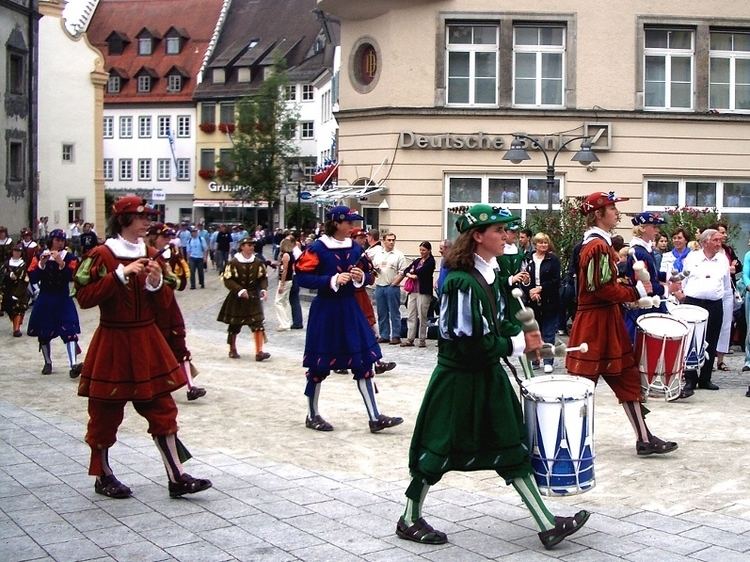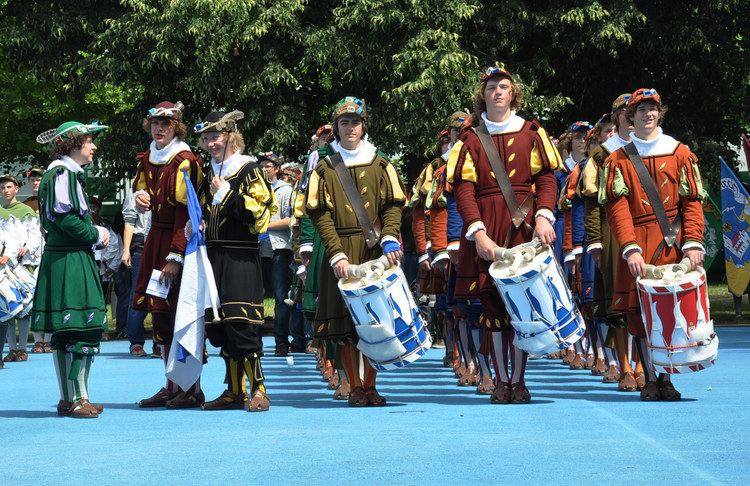 | ||
Rutenfest ravensburg sch tzenk nig b rengarten 2016
Rutenfest (literally birch whip festival) is an annual town festival in Ravensburg, Upper Swabia, Germany. At the end of the school term (usually in July), local pupils and adult citizens take part in many Rutenfest events including a parade watched by tens of thousands of spectators. Rutenfest is generally considered the high spot of Ravensburg's city life. Alumni of local schools flock back to their hometown, to meet family and friends at the events officially organized by the Rutenfest Commission, and at hundreds of private parties.
Contents
- Rutenfest ravensburg sch tzenk nig b rengarten 2016
- Rutenfest ravensburg festzug 2014
- Etymology
- Traditions
- Award ceremonies
- Rutentheater
- Drumming groups
- Parade
- Shooting competitions
- Other events
- References

Rutenfest ravensburg festzug 2014
Etymology

There are several folk festivals in South Germany that bear the name "Rutenfest", notably those in Ravensburg and Landsberg am Lech (the latter spelled Ruethenfest), and a smaller festival in Bopfingen. Several explanations of the name have been brought forward over the years. Most likely, birch whips used for beating the pupils were a symbol of mastering Latin grammar, and pupils were solemnly awarded with such a birch at the end of each school term. Those birches were cut in the woods around town in some sort of a school outing before the festival.
Traditions

Rutenfest Ravensburg goes back to the 17th century, the custom of "going (to/with) the birches" being first mentioned in a municipal law in 1645.

Rutenfest is celebrated from the last Friday of school term ("Ruten Friday") over a long weekend until Tuesday ("Ruten Tuesday"). On "Ruten Monday", most shops and offices in Ravensburg are closed. Schools are closed on Monday and Tuesday.
During all Rutenfest days, funfair attractions (including a large mobile ferris wheel), beer gardens, beer tents and food stands are open to the public in an area north of the old town called Kuppelnau. While Rutenfest Ravensburg features several elements of Volksfests with beer gardens and funfairs like the much larger Munich Oktoberfest, it boasts a lot of local traditions that distinguish it from other German town festivals.
The citizens of Ravensburg celebrate their town with thousands of flags (in blue and white, the town's colors) that can be seen all over the town, and with a lot of local patriotism. The local anthem Mein Ravensburg im Schwabenland (My Ravensburg in the country of Swabia) is sung at all official events, and often spontaneously in beer gardens.
All official events are heralded with three cannon salutes from the town's highest watchtower, the medieval Mehlsack. These salutes can be heard across the whole town.
Award ceremonies
The oldest tradition still performed at today's Rutenfest is the solemn presentation of an award for the best female and male pupils. The tradition can be traced back to the 17th century. The awards are presented during the second of two large events at the multi-purpose hall Oberschwabenhalle that also feature dance, sport and music performances by local schools. The laureates are called "Oberstköniginnen“ and "Oberstfähnriche" and take part in the Monday Parade. In 2013, the tradition was changed: not only pupils of elementary secondary schools, but students of all schools are now eligible for these traditional honors. The pupils are no longer those with the best grades but those that have the best record in extracurricular activities and involvement in school life. The tradition that the pupils wear 18th-century style dresses and uniforms during the ceremony and at the parade was abolished. Hence the group has been the only one in the 2013 parade that was not wearing historical costumes but rather unsightly T-shirts and sweaters.
Rutentheater
Occasional theatre performances have been held during Rutenfest from at least 1697. Since 1821, local schools have been presenting plays and declamations, which means that Rutentheater has one of the longest traditions in German amateur theatre. Since 1898, Rutentheater is held at the sumptuous Konzerthaus theatre. As of 2012, two casts of 50 pupils (plus a pupils' wind orchestra and ballet dancers) present a fairytale production in a total of 17 performances (with c. 500 patrons each) starting one week before "Ruten Friday". The performances are usually sold out well in advance.
Drumming groups
Over the Rutenfest days (from Friday until Tuesday), several bands in historic costumes are marching through the city playing drums and fifes, pipes or fanfares. The groups play two or three pieces at the homes of diginitaries, former group members, and friends (a custom called Antrommeln). In return, the groups are rewarded with donations to compensate their expenses, and are sometimes invited to food and drink. Around these short performances, many citizens organize garden or street parties where their friends and old classmates are also invited. Since the drumming starts as early as 7am and stops only at 10pm, some drumming can nearly always be heard at any point in town during Rutenfest.
Some of the drumming groups are formed by pupils to represent their schools and can only be seen during the Rutenfest days:
Former members of the pupils' drumming groups (Ehemalige) usually keep the hat of their costumes and wear this hat lifelong during the festival. Ehemalige are organized in clubs and organize various parties and events during the Rutenfest and at other times of the year.
There are also several drumming groups of male grown-up citizens that are exclusively heard at Rutenfest:
The following fanfare bands play not only at Rutenfest, but take part in Rutenfest events including the Antrommeln custom:
Parade
On "Ruten Monday" morning, a big parade called Historischer Rutenfestzug with roughly 6,000 participants winds its way through the old town of Ravensburg. 4,500 pupils and adults parade in historical costumes presenting the town's history from medieval times, when Ravensburg was an international trading centre, to the 19th century. The three-hour-long parade also includes 120 horse-drawn carriages, all Rutenfest drumming groups, and many wind and brass bands from Upper Swabia with c. 1,200 musicians in total. In 2012, c. 50,000 spectators lined the streets along the parade.
Shooting competitions
The festival features several annual shooting competitions where local pupils compete for the title Schützenkönig (champion marksman). All these open-air competitions are held in the Kuppelnau area.
Every five years, thousands of local grammar school alumni from all over the world gather to the Altenschiessen (roughly translated as "shooting by seniors") on "Ruten Sunday". Targets and rules are the same as those of the Adlerschiessen. Participants shoot in reverse age order, with the oldest participant starting the event (in 2015 this was Guido Erb, born in 1920). The champion is called Altschützenkönig. The first Altenschiessen was held in 1900. In 2015, the competition had over 2,300 participants.
Realschule alumni organize a similar alumni shooting with bows and arrows (Bogenschiessen aller ehemaligen RealschülerInnen) that has taken place every five years since 1996.
Other events
On "Ruten Friday" afternoon in a ceremony in the Schwörsaal hall, the "Trommlerkorps" is presented with school flags and other insignia by the mayor of Ravensburg. After that, the festival is officially opened by the mayor on the central Marienplatz square, followed by a performance of all pupils' drumming groups.
On "Ruten Saturday" night, Ravensburg's central square, the Marienplatz, is populated by some 20,000 people at the Fröhlicher Auftakt (roughly translated as "blightful beginning"). This event has continually grown since its first instalment in the 1960s. Wine (and increasingly beer) is served.
On "Ruten Sunday" morning, an ecumenical open-air church service is held by the local Catholic and Protestant parishes on Marienplatz.
Public fireworks on "Ruten Tuesday" night mark the end of the five days of Rutenfest.
In the aftermath, two further events take place:
